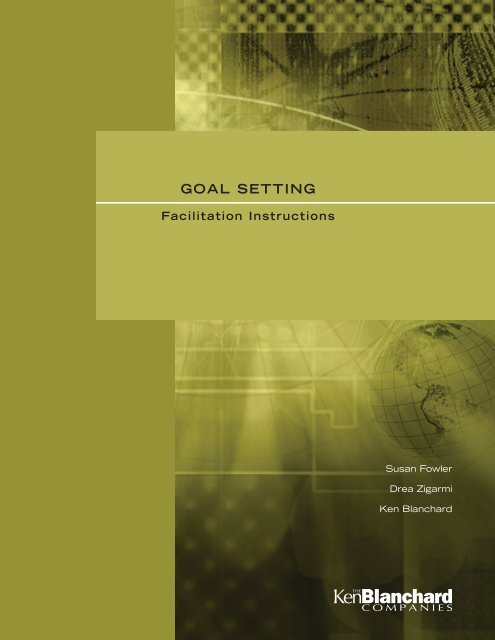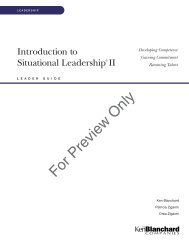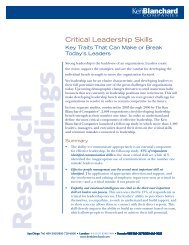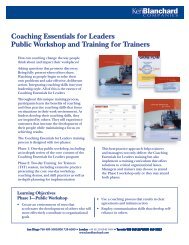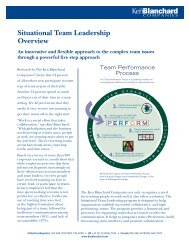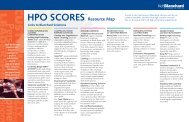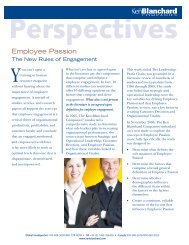GOAL SETTING - Ken Blanchard
GOAL SETTING - Ken Blanchard
GOAL SETTING - Ken Blanchard
Create successful ePaper yourself
Turn your PDF publications into a flip-book with our unique Google optimized e-Paper software.
<strong>GOAL</strong> <strong>SETTING</strong><br />
Facilitation Instructions<br />
Susan Fowler<br />
Drea Zigarmi<br />
<strong>Ken</strong> <strong>Blanchard</strong>
<strong>GOAL</strong> <strong>SETTING</strong><br />
FacILITATION INSTRUCTIONS<br />
Authors<br />
Susan Fowler<br />
Drea Zigarmi<br />
<strong>Ken</strong> <strong>Blanchard</strong><br />
Product Developer<br />
Kim King<br />
Art Director<br />
Beverly Haney<br />
Production Artists<br />
Kara Meredith<br />
Kim King<br />
Vanessa Gagos<br />
Project Manager<br />
Kim King<br />
Proofreaders<br />
Carey Nash<br />
Linda Hulst<br />
D’Andra La Pierre<br />
Brand Manager<br />
Victoria Cutler<br />
<strong>Ken</strong> <strong>Blanchard</strong> first developed Situational Leadership ® with Paul Hersey in the late 1960s. In 1985, <strong>Blanchard</strong><br />
and the Founding Associates of The <strong>Ken</strong> <strong>Blanchard</strong> Companies ® —Marjorie <strong>Blanchard</strong>, Don Carew, Eunice<br />
Parisi-Carew, Fred Finch, Laurence Hawkins, Drea Zigarmi, and Patricia Zigarmi—created a new generation of<br />
the theory called Situational Leadership ® II. The leadership model used in this product is based on the Founding<br />
Associates’ second generation thinking and research, and is used with their permission.<br />
Situational Leadership ® is a registered trademark of Leadership Studies, Inc.<br />
© Copyright 2012 by The <strong>Ken</strong> <strong>Blanchard</strong> Companies. All rights reserved. Do not duplicate.<br />
These materials have been designed to develop specific knowledge and skills and have been thoroughly<br />
tested to ensure their effectiveness. They represent the proprietary intellectual property of The <strong>Ken</strong> <strong>Blanchard</strong><br />
Companies ® and are protected under international copyright law. These materials may not be reproduced in<br />
whole or in part in any form without the prior written permission of The <strong>Ken</strong> <strong>Blanchard</strong> Companies.<br />
Environmental Statement<br />
The <strong>Ken</strong> <strong>Blanchard</strong> Companies strives to conserve natural resources by minimizing<br />
consumption of resources and energy, reducing emissions, and increasing awareness<br />
so that future generations will inherit a healthy, sustainable planet.<br />
Global Headquarters USA +1 760 489-5005 • 800 728-6000 • Fax +1 760 489-8407<br />
UK +44 (0) 1483 456300 Canada +1 905 829-3510 • 800 665-5023 Singapore +65 6775 1030<br />
www.kenblanchard.com<br />
Item # 18014<br />
V033012
<strong>GOAL</strong> <strong>SETTING</strong><br />
FACILITATION INSTRUCTIONS<br />
Table of Contents<br />
Preface..............................................................................................................v<br />
Preparation<br />
Activities<br />
Training Preparation .........................................................................................1<br />
Goal Setting Materials.......................................................................................2<br />
Tools for Success...............................................................................................3<br />
Goal Setting Training Design.............................................................................5<br />
Goal Setting Visual Aids Overview....................................................................9<br />
Goal Setting PowerPoint ® Slides.......................................................................10<br />
Goal Setting Flip Charts...................................................................................16<br />
Activity 1: Session Lead-In.................................................................................1<br />
Activity 2: Welcome and Introductions..............................................................3<br />
Activity 3: Obstacles and Benefits.....................................................................5<br />
Activity 4: Learning Objectives..........................................................................9<br />
Activity 5: KRA, Goal, and Task Statement Sort—Part 1.................................13<br />
Activity 6: KRA, Goal, and Task Statement Sort—Part 2.................................17<br />
Activity 7: Maria Hernandez Case Study.........................................................21<br />
Activity 8: SMART Goals.................................................................................29<br />
Activity 9: In Your Own Words........................................................................45<br />
Activity 10: SMART Goal Skill Practice............................................................47<br />
Activity 11: Action Planning............................................................................53<br />
Activity 12: Closing.........................................................................................55<br />
© 2012 The <strong>Ken</strong> <strong>Blanchard</strong> Companies. All rights reserved. Do not duplicate • Item # 18014 • V033012 iii
<strong>GOAL</strong> <strong>SETTING</strong><br />
FACILITATION INSTRUCTIONS<br />
Preface<br />
As a facilitator of this half-day session, your role is two-fold. Clearly, you are tasked to<br />
improve the goal setting competence of managers and self-leaders. But, perhaps even<br />
more importantly, your job includes building their commitment to goal setting.<br />
Think about this: Goal setting unleashes the hope of opportunity and the power of<br />
action. So, why is it that the people in your organization aren’t more excited about<br />
setting goals In this workshop, participants are asked to consider the obstacles to<br />
goal setting—and there are many—not the least of which is that most people do not<br />
know how to set meaningful, effective goals. You will also ask participants to consider<br />
the benefits of goal setting—and there are many. When you teach participants the<br />
skill of goal setting, you go a long way to helping them embrace the practice, but the<br />
way you teach the skill is what will help participants recognize and appreciate how the<br />
benefits of goal setting outweigh the obstacles.<br />
A few insights we hope are helpful …<br />
• Realize that goal setting is an iterative process—not an exact science. When the<br />
process is followed, more positive outcomes will result. In this workshop, the process<br />
includes writing a goal statement and validating it using the SMART criteria.<br />
• SMART goals have been around for a long time. There’s a good chance your<br />
organization uses the acronym. Note that we have changed the standard elements:<br />
The S is Specific and measurable; the M stands for Motivating. This new take on<br />
SMART allows you to use your version of SMART and enhance it with the latest<br />
research regarding motivation and goal setting. Setting goals that can sustain<br />
motivation over time is one of the most critical new developments for improving<br />
goal achievement, productivity, and performance. Study the work done by Edward<br />
Deci and Richard Ryan for a deeper understanding and appreciation for the role<br />
motivation plays in goal setting.<br />
• Set goals. Be a goal setter. Understand the mechanics of goal setting. Embrace the<br />
process for yourself. Teach from first-hand knowledge.<br />
© 2012 The <strong>Ken</strong> <strong>Blanchard</strong> Companies. All rights reserved. Do not duplicate • Item # 18014 • V033012 v
FACILITATION INSTRUCTIONS<br />
Preface<br />
<strong>GOAL</strong> <strong>SETTING</strong><br />
• Use the examples we have provided in the facilitator instructions and PowerPoint®<br />
to teach the goal setting process. Using metaphors for learning is the best way to<br />
learn a process—it focuses participants on the process itself, rather than getting<br />
hung up or stuck on the content of the case study or example. The shift from<br />
learning through metaphors to application in reality takes place during the lab<br />
where participants practice the process and are asked to write their own goal<br />
statements. Here it could prove helpful to prepare prototypical goal examples that<br />
are relevant to them and their organization.<br />
• This half-day session can be built into a full day where participants take the time to<br />
write the goals for their performance review plans.<br />
If you think teaching goal setting might be boring, grueling, and/or painful—you need<br />
to trust us. Teaching people how to capture their dreams and craft them into reality is<br />
stimulating and rewarding. When you teach leaders how to do that with their direct<br />
reports, you are beginning to create a legacy of motivated and productive employees.<br />
It doesn’t get much better than that!<br />
Susan Fowler<br />
Drea Zigarmi<br />
<strong>Ken</strong> <strong>Blanchard</strong><br />
vi<br />
© 2012 The <strong>Ken</strong> <strong>Blanchard</strong> Companies. All rights reserved. Do not duplicate • Item # 18014 • V033012
<strong>GOAL</strong> <strong>SETTING</strong><br />
FACILITATION INSTRUCTIONS<br />
Goal Setting Training Design<br />
Activity Title Minutes Schedule<br />
1 Session Lead-In 15<br />
2 Welcome and Introductions 5<br />
3 Obstacles and Benefits 10<br />
4 Learning Objectives 5<br />
5 KRA, Goal, and Task Statement Sort—Part 1 20<br />
6 KRA, Goal, and Task Statement Sort—Part 2 15<br />
7 Maria Hernandez Case Study 20<br />
Break 10<br />
8 SMART Goals 60<br />
9 In Your Own Words 10<br />
Break 10<br />
10 SMART Goal Skill Practice 65<br />
11 Action Planning 14<br />
12 Closing 11<br />
T total Training Time 4 hours 30 minutes<br />
(includes Breaks)<br />
© 2012 The <strong>Ken</strong> <strong>Blanchard</strong> Companies. All rights reserved. Do not duplicate • Item # 18014 • V033012 Preparation 5
FACILITATION INSTRUCTIONS<br />
Goal Setting Training Design<br />
<strong>GOAL</strong> <strong>SETTING</strong><br />
Activity Description Minutes Schedule*<br />
1 Session Lead-In<br />
Ask participants to identify goals that are<br />
8:15 a.m.–8:30 a.m.<br />
relevant to them for use during the session. 15 12:45 p.m.–1:00 p.m.<br />
2 Welcome and Introductions 8:30 a.m.–8:35 a.m.<br />
Welcome and conduct participant introductions. 5 1:00 p.m.–1:05 p.m.<br />
3 Obstacles and Benefits<br />
Ask participants to discuss their thoughts about<br />
possible obstacles and challenges to goal setting.<br />
Next, discuss the benefits to goal setting. Share<br />
8:35 a.m.–8:45 a.m.<br />
the “rubber band” analogy. 10 1:05 p.m.–1:15 p.m.<br />
4 Learning Objectives<br />
Review purpose of the workshop and present<br />
learning outcomes. Present workshop norms.<br />
Review logistics. Introduce Ideas, Insights,<br />
8:45 a.m.–8:50 a.m.<br />
and Intentions. 5 1:15 p.m.–1:20 p.m.<br />
5 KRA, Goal, and Task Statement Sort—Part 1<br />
Introduce and define KRA, Goal, and Task<br />
Statements. Introduce the game plan. Ask<br />
partners to sort 20 statements into either KRA,<br />
8:50 a.m.–9:10 a.m.<br />
Goal, or Task categories. 20 1:20 p.m.–1:40 p.m.<br />
6 KRA, Goal, and Task Statement Sort—Part 2<br />
Ask participants to deepen their learning by<br />
once again sorting the 20 statements into four<br />
topic groups—Production, Health, Sales, and<br />
Training. Reinforce the importance of knowing<br />
9:10 a.m.–9:25 a.m.<br />
the differences between KRA, goal, and task. 15 1:40 p.m.–1:55 p.m.<br />
7 Maria Hernandez Case Study<br />
Introduce the case study that uses baseball as<br />
the subject. Present the case study resources.<br />
Ask partners to write an Achieve • Outcome • When<br />
goal statement for Maria. Ask pairs to share<br />
9:25 a.m.–9:45 a.m.<br />
statements with the large group. 20 1:55 p.m.–2:15 p.m.<br />
9:45 a.m.–9:55 a.m.<br />
Break 10 2:15 p.m.–2:25 p.m.<br />
* Two schedules are given: one is for a morning workshop, and the other is for an afternoon workshop.<br />
6 Preparation © 2012 The <strong>Ken</strong> <strong>Blanchard</strong> Companies. All rights reserved. Do not duplicate • Item # 18014 • V033012
<strong>GOAL</strong> <strong>SETTING</strong><br />
FACILITATION INSTRUCTIONS<br />
Goal Setting Training Design<br />
Activity Description Minutes Schedule<br />
8 SMART Goals<br />
Present the five fundamentals of SMART<br />
goal setting. Introduce SMART Questions<br />
cards. Conduct five skill practice rounds to<br />
allow partners to answer SMART Questions<br />
9:55 a.m.–10:55 a.m.<br />
and revise their goal statement for Maria. 60 2:25 p.m.–3:25 p.m.<br />
9 In Your Own Words<br />
Ask participants to stand up and share<br />
with a partner their key learning from<br />
the previous activities. Conduct three rounds<br />
of sharing, asking participants to repeat each<br />
10:55 a.m.–11:05 a.m.<br />
person’s key point with each round. 10 3:25 p.m.–3:35 p.m.<br />
11:05 a.m.–11:15 a.m.<br />
Break 10 3:35 p.m.–3:45 p.m.<br />
10 SMART Goal Skill Practice<br />
Ask participants to identify a KRA relevant to<br />
them. Ask them to write the KRA in the form<br />
of an Achieve • Outcome • When goal statement.<br />
Have partners provide guidance to each other to<br />
revise their KRA statement using the SMART<br />
Questions cards. Ask participants to use the<br />
SLII ® Leadership Styles 3 and 2 with their partner.<br />
Review the leadership styles if necessary.<br />
Review extra credit from partners who write<br />
11:15 a.m.–12:20 p.m.<br />
Performs Activity • How task statements. 65 3:45 p.m.–4:50 p.m.<br />
11 Action Planning<br />
Ask participants to create an action plan that<br />
identifies what ideas or behaviors they will<br />
commit to using in the next two weeks. Conduct<br />
12:20 p.m.–12:34 p.m.<br />
sharing of action plans with table groups. 14 4:50 p.m.–5:04 p.m.<br />
12 Closing<br />
Ask participants to reflect on and record their<br />
key learnings from the session. Ask for volunteers<br />
to share key insights. Summarize and close the<br />
12:34 p.m.–12:45 p.m.<br />
session. 11 5:04 p.m.–5:15 p.m.<br />
© 2012 The <strong>Ken</strong> <strong>Blanchard</strong> Companies. All rights reserved. Do not duplicate • Item # 18014 • V033012 Preparation 7
<strong>GOAL</strong> <strong>SETTING</strong><br />
FACILITATION INSTRUCTIONS<br />
Activity 1<br />
Session Lead-In<br />
15 minutes<br />
P u r p o s e ♦ ♦ ♦<br />
Participants identify goals<br />
that are meaningful to them<br />
as a way to reinforce the<br />
workshop’s relevance.<br />
1. Conduct Session Lead-In large group 15 min.<br />
■■<br />
Display visual aid 1—Goal Setting Challenge.<br />
■■<br />
Greet participants as they enter the room and direct them to<br />
sit at a table.<br />
Refer to workbook page 1—Goal Setting Challenge.<br />
■■<br />
Ask participants to complete the tasks listed on the visual aid<br />
before the workshop begins.<br />
© 2012 The <strong>Ken</strong> <strong>Blanchard</strong> Companies. All rights reserved. Do not duplicate • Item # 18014 • V033012 ACTIVitieS 1
<strong>GOAL</strong> <strong>SETTING</strong><br />
FACILITATION INSTRUCTIONS<br />
Activity 2<br />
Welcome and Introductions<br />
5 minutes<br />
P u r p o s e ♦ ♦ ♦<br />
Participants are welcomed<br />
and engage in a discussion as<br />
a way of creating an active<br />
and participative environment<br />
from the beginning.<br />
1. Introduce Workshop large group 1 min.<br />
■■<br />
Display visual aid 2—Welcome.<br />
■■<br />
Welcome participants to Goal Setting.<br />
■■<br />
Introduce yourself.<br />
■■<br />
Give this direction …<br />
Welcome to the Goal Setting workshop. I am going to ask you a<br />
series of questions and, as I ask each question, please raise your<br />
hand if the answer is “yes.”<br />
■■<br />
Ask these questions …<br />
Do you have a current personal or professional goal that is<br />
demotivating or getting you down just thinking about it<br />
Do you have a personal or professional goal you want to achieve<br />
over the next six months<br />
Do you manage or supervise someone who has a goal that is<br />
demotivating or getting them down<br />
Do you manage or supervise someone who has a personal or<br />
professional goal they want to achieve over the next six months<br />
Do you need a goal<br />
Do you manage someone who needs a goal<br />
© 2012 The <strong>Ken</strong> <strong>Blanchard</strong> Companies. All rights reserved. Do not duplicate • Item # 18014 • V033012 ACTIVitieS 3
FACILITATION INSTRUCTIONS<br />
Activity 2: Welcome and Introductions<br />
<strong>GOAL</strong> <strong>SETTING</strong><br />
■■<br />
Make these remarks …<br />
The reason I asked you these questions is because most of us either<br />
have or need a goal, or manage people who have or need goals.<br />
Goals are a reality and a necessity of organizational life.<br />
Yet, as common as goal setting is—or should be—most of us can<br />
do a much better job of bringing meaning to the process. That is<br />
why we are here today—to learn how to be more effective at goal<br />
setting and to bring meaning to the process.<br />
2. Set Up Introductions Activity large group 1 min.<br />
■■<br />
Make these remarks …<br />
I’d like you to take a few minutes to become better acquainted<br />
with the others at your table. Introduce yourself and share with<br />
your table group either a current goal you have identified as being<br />
challenging or demotivating to you or a goal that you would like to<br />
achieve in the next six months.<br />
3. Conduct Introductions Activity small groups 3 min.<br />
4 ACTIVitieS © 2012 The <strong>Ken</strong> <strong>Blanchard</strong> Companies. All rights reserved. Do not duplicate • Item # 18014 • V033012
<strong>GOAL</strong> <strong>SETTING</strong><br />
FACILITATION INSTRUCTIONS<br />
Activity 3<br />
Obstacles and Benefits<br />
10 minutes<br />
P u r p o s e ♦ ♦ ♦<br />
Participants discuss the<br />
obstacles and benefits of goal<br />
setting as a way to shift their<br />
potentially unenthusiastic<br />
feelings about goal setting<br />
by first acknowledging their<br />
challenges and negative<br />
opinions, and then by<br />
highlighting potential<br />
benefits.<br />
1. Set Up Obstacles Discussion large group 1 min.<br />
■■<br />
Display visual aid 3—Consider This … What is the problem<br />
with goal setting<br />
P r e p a r a t i o n ■ ■ ■<br />
Have a rubber band available<br />
to use in step 4.<br />
R e f e r e n c e • • •<br />
Visual aid 3 is a four-part<br />
build. Click to reveal each of<br />
the bulleted questions.<br />
■■<br />
Ask these questions …<br />
Why don’t most leaders set effective goals Why do people<br />
find goal setting so difficult What are some of the obstacles to<br />
effective goal setting<br />
Refer to workbook page 2—Consider This ….<br />
■■<br />
Give this direction …<br />
Take a minute to record your responses to these questions in your<br />
workbook on page 2.<br />
2. Conduct Obstacles Discussion large group 3 min.<br />
■■<br />
Allow a minute for participants to record their answers.<br />
■■<br />
Ask this question …<br />
What obstacles did you identify<br />
© 2012 The <strong>Ken</strong> <strong>Blanchard</strong> Companies. All rights reserved. Do not duplicate • Item # 18014 • V033012 ACTIVitieS 5
FACILITATION INSTRUCTIONS<br />
Activity 3: Obstacles and Benefits<br />
<strong>GOAL</strong> <strong>SETTING</strong><br />
■■<br />
Elicit responses, such as …<br />
• Not enough time<br />
• Objectives from management are unclear<br />
• Don’t have enough information to set goals<br />
• Don’t want to run the nonprofit like a business<br />
• Waste of time<br />
• Don’t know how<br />
• Don’t see the value in it<br />
• Constant changes make goals irrelevant<br />
■■<br />
Make these remarks …<br />
The list of reasons not to set goals is a good, long list. No wonder<br />
people prefer not to set goals—especially in the workplace<br />
where they may seem like a waste of time or an opportunity for<br />
highlighting failures.<br />
3. Set Up Benefits Discussion large group 1 min.<br />
R e f e r e n c e • • •<br />
Visual aid 4 is a two-part<br />
build. Click to reveal the<br />
subcategories.<br />
■■<br />
Display visual aid 4—Consider This … What are the benefits<br />
of goal setting<br />
6 ACTIVitieS © 2012 The <strong>Ken</strong> <strong>Blanchard</strong> Companies. All rights reserved. Do not duplicate • Item # 18014 • V033012
<strong>GOAL</strong> <strong>SETTING</strong><br />
FACILITATION INSTRUCTIONS<br />
Activity 3: Obstacles and Benefits<br />
■■<br />
Ask these questions …<br />
Why bother to set goals What are the benefits of goal setting<br />
from the perspective of the individual, the leader, and the<br />
organization<br />
Refer again to workbook page 2—Consider This ….<br />
■■<br />
Give this direction …<br />
Take a minute to record your responses in your workbook.<br />
4. Conduct Benefits Discussion large group 4 min.<br />
■■<br />
Allow a minute for participants to record their answers.<br />
■■<br />
Ask this question …<br />
What did you come up with for the benefits of goal setting<br />
■■<br />
Elicit responses, such as …<br />
• A goal gives you a place to start<br />
• Without a goal, there is little hope for positive action<br />
• Objectives put your time into perspective—you know what is<br />
important and what isn’t<br />
• Goals help you assert your intentions when others are<br />
demanding a piece of your time<br />
R e f e r e n c e • • •<br />
Use a rubber band to provide<br />
this example. If you don’t<br />
have one, you can use an<br />
imaginary rubber band to<br />
simulate the demonstration.<br />
■■<br />
Reinforce these ideas …<br />
Another important reason for setting goals is that goal setting<br />
sets up creative or dynamic tension that spurs you or others into<br />
action. Here is an example: As I stretch this rubber band, imagine<br />
the end of my left hand represents my current reality and the end<br />
in my right hand represents the outcome I want—the end result<br />
of achieving my goal. Simply by setting a goal, I create a dynamic<br />
tension.<br />
© 2012 The <strong>Ken</strong> <strong>Blanchard</strong> Companies. All rights reserved. Do not duplicate • Item # 18014 • V033012 ACTIVitieS 7
FACILITATION INSTRUCTIONS<br />
Activity 3: Obstacles and Benefits<br />
<strong>GOAL</strong> <strong>SETTING</strong><br />
R e f e r e n c e • • •<br />
If participants are familiar<br />
with the Situational<br />
Leadership ® II or Needs<br />
Models, reinforce that it is<br />
difficult, if not impossible,<br />
to diagnose an individual’s<br />
development level without a<br />
clear goal. A good diagnosis<br />
demands a good goal.<br />
■■<br />
Make these remarks …<br />
These are excellent reasons to set goals—especially the notion that<br />
if you are managing others you need to begin the development and<br />
coaching process by agreeing on goals and expectations.<br />
Whether the tension is in this rubber band, or in my life as a goal,<br />
what does nature want to do with that tension Release it. To<br />
release the tension in this rubber band, I have two choices. I can<br />
let go of my goal—by releasing the end from my right hand. That<br />
can hurt! What may hurt even more is that by releasing the goal, I<br />
have not changed my current reality. I am stuck where I started.<br />
The other choice I have is to follow what has been called the path of<br />
least resistance. Notice as I move my left hand closer to my right,<br />
that I am releasing the tension. But, unlike the first scenario, I<br />
have moved closer to my goal and dramatically changed my current<br />
reality.<br />
If you are looking to create or control changes in your life, set a<br />
goal and follow the path of least resistance. As a manager, being<br />
an effective goal setter is a huge step toward more motivated and<br />
passionate employees.<br />
5. Summarize Activity large group 1 min.<br />
■■<br />
Make these points …<br />
Although the list of potential benefits may not be as long as the list<br />
of potential obstacles, we hope you recognize that the positives of<br />
goal setting are so powerful that they outweigh the negatives. If<br />
that is not apparent yet, we hope to make the case for setting goals<br />
by the end of the session.<br />
8 ACTIVitieS © 2012 The <strong>Ken</strong> <strong>Blanchard</strong> Companies. All rights reserved. Do not duplicate • Item # 18014 • V033012


